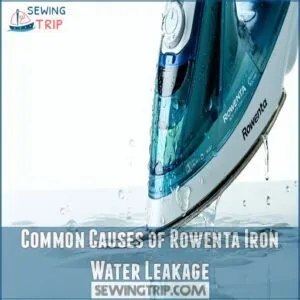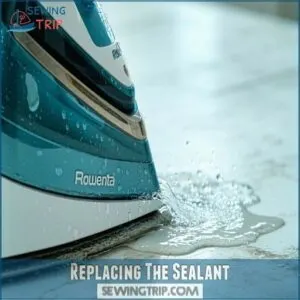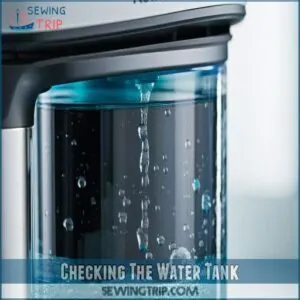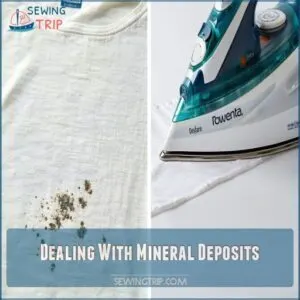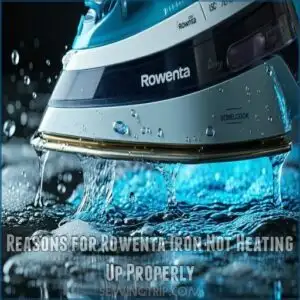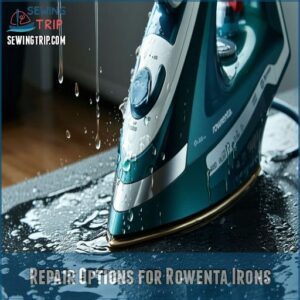This site is supported by our readers. We may earn a commission, at no cost to you, if you purchase through links.
 Is your Rowenta iron turning ironing into a splash zone? Don’t panic! Water leaks often stem from simple issues like overfilled reservoirs, mineral buildup, or worn-out sealants.
Is your Rowenta iron turning ironing into a splash zone? Don’t panic! Water leaks often stem from simple issues like overfilled reservoirs, mineral buildup, or worn-out sealants.
First, check your water tank’s fill level and use distilled water to prevent mineral deposits.
If you’re seeing water spots, mix white vinegar and water, let it sit for 30 minutes, then drain and rinse thoroughly.
Inspect the sealant for cracks and consider replacing it with high-temperature silicone.
Still leaking? You might need to check the steam buttons or valve. Regular maintenance can save you from unexpected laundry day waterworks.
Table Of Contents
- Key Takeaways
- Common Causes of Rowenta Iron Water Leakage
- How to Fix a Leaking Rowenta Iron
- Troubleshooting The Steam and Spray Buttons
- Reasons for Rowenta Iron Not Heating Up Properly
- Time Required for Rowenta Iron to Heat Up
- Dealing With Water Spitting From The Iron
- Rowenta Iron Not Maintaining Heat
- Fixing The Auto Shut Off Feature in Rowenta Irons
- Repair Options for Rowenta Irons
- Frequently Asked Questions (FAQs)
- Conclusion
Key Takeaways
- You’ll stop most leaks by using distilled water and avoiding overfilling your iron’s reservoir, which prevents mineral buildup and reduces pressure on internal seals.
- Check your iron’s seals regularly and replace them with high-temperature silicone if you notice cracks or deterioration, as worn-out seals are a common source of water leakage.
- Clean your iron’s steam vents and buttons periodically with white vinegar and a cotton swab to remove mineral deposits that can cause unexpected water spitting and steam malfunctions.
- Always empty your water tank after ironing, store the iron properly, and perform monthly descaling to maintain its performance and prevent unexpected leaks during future use.
Common Causes of Rowenta Iron Water Leakage
Ever stared in horror as your Rowenta iron turns your crisp shirt into a soggy mess? Water leakage can turn ironing from a simple chore into a laundry nightmare. Let’s explore why your iron might be playing water tag with your clothes.
An overfilled reservoir is often the prime suspect. Push past the max line, and you’re inviting water to escape through every tiny opening. Dried-out sealant can also be a sneaky culprit, losing its grip and letting water slip through like a mischievous leak.
Hard water is another troublemaker. Those mineral buildups can clog steam vents faster than rush hour traffic, creating pressure points that force water to escape. Faulty steam buttons and temperamental thermostats join the leak party, disrupting your iron’s iron smooth performance.
Sometimes, a damaged tank or valve can turn your iron into a mini water fountain. Each drip is a signal that something’s not right – understanding the root causes is your first step to dry, wrinkle-free clothes.
How to Fix a Leaking Rowenta Iron
Is your Rowenta iron leaving water spots on your favorite shirt instead of creating crisp, clean lines?
Don’t worry—we’ve got some quick and easy fixes.
that’ll have you ironing like a pro in no time.
Replacing The Sealant
Worn-out sealant could be the culprit behind your Rowenta iron’s water leak. Replacing the sealant isn’t rocket science—you’ve got this!
Check the sealant for cracks or deterioration.
You can find the right Rowenta iron sealant replacement online, such as Rowenta sealant products. Use high-temperature silicone sealant designed for irons. Apply carefully to prevent future leaking.
A fresh sealant might just save your iron from becoming a water-spewing disaster. Quick fix, problem solved!
Checking The Water Tank
Under the lid of your Rowenta iron, a hidden culprit might be causing water leaks.
Check the tank’s condition carefully, looking for cracks, damage, or wear that could compromise its seal.
Gently inspect the water tank’s attachment points and edges. Make certain it’s securely fitted without any visible stress points that might trigger unexpected leakage during ironing.
Dealing With Mineral Deposits
After inspecting your water tank, you’ll want to tackle those pesky mineral deposits that can wreak havoc on your Rowenta iron. Here’s your game plan for mineral deposit removal:
- Mineral buildup stops here!
- Reclaim your iron’s performance
- Save money on replacements
- Enjoy smoother, cleaner ironing
Mix equal parts white vinegar and water to create a powerful descaling solution.
Fill the iron’s tank and let it sit for 30 minutes, giving those limescale invaders a one-way ticket out. Drain completely, rinse thoroughly with clean water, and wipe down with a soft cloth.
Pro tip: Use distilled water to prevent future mineral buildup and keep your Rowenta iron running like a champ. Your clothes will thank you!
Troubleshooting The Steam and Spray Buttons
Got a Rowenta iron with wonky steam and spray buttons? No sweat!
Start by cleaning those stubborn buttons with a cotton swab dipped in white vinegar. If the steam button’s stuck, gently work it back and forth to loosen any gunk.
Clogged vents can mess with your spray function, so grab a toothpick and carefully clear out those tiny holes.
Sometimes mineral buildup is the culprit behind Rowenta iron leaking water or spitting steam. Pro tip: use distilled water to prevent these pesky issues.
When cleaning, be gentle but thorough – you don’t want to damage those sensitive buttons.
If simple cleaning doesn’t solve your Rowenta steam iron problems, it might be time to check for internal issues or consider professional repair.
Reasons for Rowenta Iron Not Heating Up Properly
If your steam and spray buttons seem fine, let’s dig into why your Rowenta iron might be giving you the cold shoulder regarding heating. Heating element failure can turn your ironing dream into a frustrating nightmare.
When your iron’s not warming up, you’re facing a potential showdown with several sneaky culprits:
- Power cord issues that interrupt your iron’s electrical lifeline
- Thermostat problems throwing temperature control out the window
- Internal wiring faults hiding beneath the surface
- Faulty switches playing hide and seek with your iron’s performance
- Damaged heating elements blocking the path to crisp, wrinkle-free clothes
These Rowenta iron problems aren’t just minor hiccups – they’re full-blown performance stoppers. A malfunctioning heating element means your clothes stay stubbornly wrinkled, and your ironing session turns into a wrestling match with cold fabric and persistent creases.
Time Required for Rowenta Iron to Heat Up
Your Rowenta iron’s lightning-fast heating time is about to become your secret weapon against wrinkled chaos. Plug in this powerhouse, and within 2 to 5 minutes, you’ll have a temperature-ready companion ready to tackle even the most stubborn creases. Its heat-up speed is like a well-oiled machine – quick, efficient, and ready when you are.
No more waiting around while your iron slowly warms up; Rowenta understands that time is precious.
Whether you’re prepping for a big meeting or rushing to smooth out Sunday’s dress shirts, this iron’s temperature control is your backstage pass to wrinkle-free perfection. Just plug in, wait a few minutes, and watch as your iron transforms from cold metal to a steam-powered pressing champion. Productivity? Maximized. Wrinkles? Destroyed.
When shopping for a new iron, consider checking out the Rowenta Iron Heat Time to achieve satisfactory performance.
Dealing With Water Spitting From The Iron
Ever wonder why your Rowenta steam iron decides to throw a water tantrum mid-ironing? Water spitting happens more often than you’d think, and it’s usually not your iron throwing a fit.
Mineral buildup is the real culprit behind those unexpected water sprays. Hard water leaves behind a nasty residue that clogs steam vents faster than you can say "wrinkle-free."
Some Rowenta users have reported more serious design flaw issues.
To prevent this wet mess, run your iron’s self-cleaning mode multiple times. Check for brown water – that’s a telltale sign of internal gunk.
Pro tip: Test the iron on the lowest steam setting and let it fully heat up before going full steam ahead. A little maintenance goes a long way in keeping your steam iron behaving like a well-oiled machine.
Rowenta Iron Not Maintaining Heat
Is your Rowenta iron giving you the cold shoulder instead of heating up like a pro? Maintaining proper heat levels is the secret sauce to wrinkle-free clothes and smooth ironing experiences. Let’s troubleshoot those frustrating temperature control gremlins. To prevent temperature issues, choosing a high-quality iron with precise temperature control is key.
- Check your power cord for any signs of wear or damage that might be choking your iron’s heat supply
- Inspect the soleplate thoroughly, clearing away any mineral buildup that could block heat transfer
- Test the steam control mechanism, ensuring buttons aren’t stuck and vents remain clear
- Test your water quality, as mineral-rich water can mess with your iron’s heating element
A finicky heating element doesn’t have to spell disaster. Most temperature issues have simple maintenance solutions. Think of your iron like a high-performance athlete – it needs the right conditions to perform at its peak. Cleaning, checking connections, and staying vigilant can transform a sluggish iron into a heat-generating powerhouse that tackles wrinkles with precision and ease.
Fixing The Auto Shut Off Feature in Rowenta Irons
Struggling with your Rowenta iron’s auto shut-off feature? You’re not alone. This safety mechanism can be a lifesaver, preventing potential fire hazards by cutting power after 8 minutes of inactivity.
If your iron’s acting up, start by checking its placement. Make sure it’s sitting correctly on the heel rest and that nothing’s blocking its movement sensors.
Gently shake the iron to reactivate it when the auto-stop light flashes.
Sometimes, a quick clean of the internal components, like the Microsteam 400 HD Laser Profile soleplate SteamForce Pro Iron, can work wonders. Dust might interfere with the sensor’s accuracy.
For persistent issues, don’t risk it – professional diagnostic assessment could save you from potential headaches and keep your ironing routine safe and smooth.
Repair Options for Rowenta Irons
When your auto shut-off feature starts acting up, you might wonder what’s next for your trusty Rowenta iron. Don’t throw in the towel just yet – you’ve got repair options that can breathe new life into your appliance.
Your Rowenta iron repair journey can take several paths:
- Sealant replacement: DIY heroes can tackle dried-out seals themselves or call in the pros
- Professional repair shops: Perfect for complex issues like temperamental steam buttons or tricky thermostats
- Warranty claims: Check your paperwork before spending cash on repairs
- Internal component fixes: Some problems require expert hands and specialized tools
- Replacement parts: Often cheaper than buying a brand new iron
Got a thermostat that’s playing hide and seek with proper heating? Professionals can diagnose and replace it faster than you can say "wrinkle-free." Steam button giving you grief? A skilled technician can clean or replace it, stopping those annoying water leaks in their tracks.
Repair costs typically range from $30 to $100, which beats purchasing a new iron. Before you commit to repairs, weigh the age of your iron against replacement costs. Sometimes, an older model might be better off retired.
Pro tip: Regular maintenance can prevent many common issues, saving you time, money, and frustration in the long run. Your iron’s performance is in your hands!
Frequently Asked Questions (FAQs)
How Can I Prevent Water Leakage in My Rowenta Iron?
You’ll dodge iron water leaks by using distilled water, avoiding overfilling, cleaning steam vents regularly, and checking the anti-drip valve.
Descale monthly.
Store your iron properly to keep it in tip-top shape.
What Should I Do if My Rowenta Iron Spits Water?
Imagine your iron hijacking your ironing session with unexpected water sprays.
Clean steam vents with a cotton swab.
Use distilled water.
Check the steam control stem rod to stop those pesky water spits.
How Can I Fix a Rowenta Iron That is Not Producing Steam?
Check your iron’s steam vents for mineral buildup.
Clean them with a cotton swab dipped in vinegar.
Use distilled water to prevent clogs.
Make certain the water tank’s full before steaming your clothes.
Why is my iron leaking water from the bottom?
Your iron’s leaking likely stems from overfilled water tanks, damaged seals, or mineral buildup.
Try using distilled water, checking the anti-drip valve, and descaling regularly to prevent annoying water drips during ironing.
Why does water leak from my Rowenta iron?
Leaky irons often stem from overfilled water tanks, mineral buildup, or damaged seals.
Clean your iron regularly, use distilled water, and don’t fill past the max line to prevent messy puddles on your ironing board.
Can you fix a Rowenta iron?
Tired of a rebellious iron giving you grief? Don’t toss it yet!
You can often fix a Rowenta iron by checking water levels, cleaning vents, descaling, and replacing worn parts – saving you money and hassle.
What should you do if your iron starts to drip water?
If your iron’s dripping, don’t panic.
Check the water tank isn’t overfilled, clean steam vents, and make certain the anti-drip valve works.
Use distilled water and descale regularly to prevent future leaks and keep your ironing smooth.
How can I prevent water leakage in my Rowenta iron?
Around 20% of iron malfunctions stem from water issues.
You’ll want to use distilled water.
Avoid overfilling the reservoir, clean steam vents regularly, and check the anti-drip valve to prevent leaks and keep your iron running smoothly.
What should I do if my Rowenta iron spits water?
Check your steam control valve and clean steam vents with a cotton swab.
Use distilled water to prevent mineral buildup.
If water continues spitting, your iron might need professional repair or replacement.
How can I fix a Rowenta iron that is not producing steam?
Clean your iron’s steam vents with a cotton swab dipped in vinegar.
Use distilled water to prevent mineral buildup.
If that doesn’t work, check the thermostat and consider professional repair for persistent steam issues.
Conclusion
Ultimately, battling a leaky Rowenta iron doesn’t have to be a frustrating chore.
Take Sarah, who thought her iron was beyond repair until she tried these simple fixes.
Whether it’s cleaning mineral deposits, checking seals, or performing routine maintenance, you’ve got the power to stop those annoying water leaks. rowenta iron leaks water
Don’t let a temperamental iron ruin your crisp clothes. With these rowenta iron leaks water troubleshooting tips, you’ll be smoothing out wrinkles like a pro in no time. simple fixes

